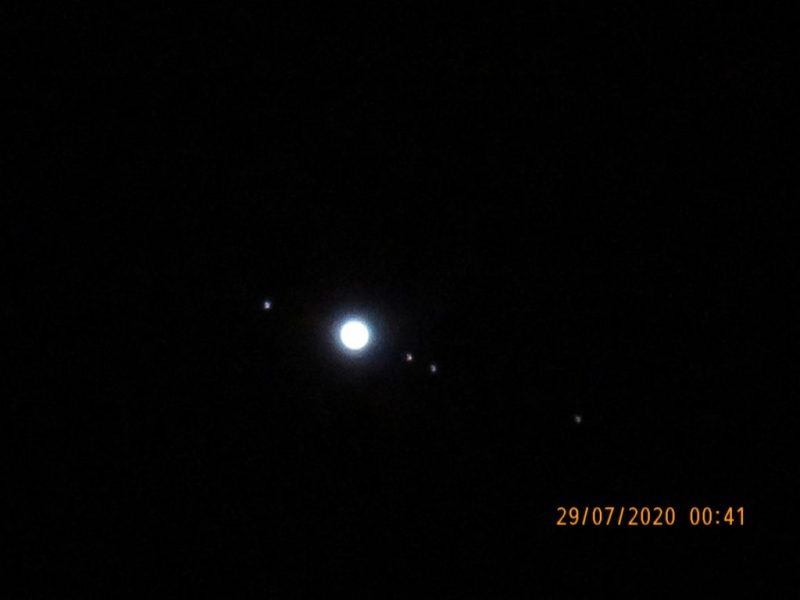As darkness falls in late July and early August 2020, let the bright moon introduce you to the king planet Jupiter and the ringed planet Saturn. As shown on the chart above, you’ll see them easily as the brightest objects near the moon. Both Jupiter and Saturn reached opposition – when Earth flew between these worlds and the sun – in July. So both are nearly at their brightest for the year right now. Thus, although the glare of the almost-full waxing gibbous moon will wash many stars from the blackboard of night, Jupiter and Saturn are easily bright enough to withstand the moon’s glare.
Jupiter and Saturn have been close on our sky’s dome throughout 2020. They’re headed for a great conjunction – their first in 20 years – before 2020 ends. That’ll be interesting, but Jupiter and Saturn will be only 30 degrees east of the sunset at the time of their conjunction. They’ll be better when this weekend, when they’re up all night, or in the several months ahead. Come to know them this weekend near the moon, and you’ll enjoy watching them!
Far and away, Jupiter is the brighter of these two worlds, beaming some 14 times more brilliantly than Saturn. Even so, Saturn is respectably bright, shining on a par with the sky’s brightest stars.
Read more: Jupiter at opposition July 13-14
Read more: Saturn at opposition July 20
Read more: Jupiter gives us Pluto in 2020
Read more: Before 2020 ends, a great conjunction of Jupiter and Saturn

Because the Earth spins from west to east on its axis of rotation, you can expect the moon, Jupiter and Saturn to travel across the night sky from east to west, just as the sun does during the day and for the same reason. Around now, these three worlds – the moon, Jupiter and Saturn – are climbing up highest for the night around midnight and setting in the west before the onset of morning dawn.
Relative to the backdrop stars and planets of the zodiac, the moon moves eastward at the rate of about 1/2 degree (the moon’s own angular diameter) per hour. In other words, the moon moves eastward on our sky’s dome around 13 degrees eastward per day.
Thus, in late July, you’ll see the moon to the west of Jupiter and Saturn. But, by early August, the moon will be sweeping past these planets.
More precisely, the moon will swing 1.5 degrees south of Jupiter on August 1, 2020, at 23:30 Universal Time (UTC) and then 2.3 degrees south of Saturn on August 2, 2020, at 13:17 UTC. Depending on where you live worldwide, the moon may or may not have its exact conjunction with either planet during the nighttime hours.
No matter where you live, look for the moon to pass by Jupiter and Saturn over the next several days. If you wish to check out the moon’s present position in front of the constellations of the zodiac, visit Heavens-Above.
Of course, although we see the moon sweep close to Jupiter and Saturn on the sky’s dome, the moon and these planets don’t come close together in space. The moon, our nearest celestial neighbor, resides about 238,000 miles (483,000 km) away from Earth. Jupiter lies way beyond the moon, somewhere around 16,000 times the moon’s distance from Earth. Saturn, the farthest world that’s easily visible to the unaided eye, is well over twice Jupiter’s distance from Earth.
Find out the moon’s present distance from Earth (in miles, kilometers or astronomical units) via The Moon Tonight.
Find out the present distance of Jupiter and Saturn from the sun and Earth (in astronomical units) via Heavens-Above.
Because the moon always appears full for two to three nights in a row, around the exact time of full moon, it’s hard to tell when the moon turns full just by looking at it. The early August 2020 full moon turns precisely full after its encounter with Jupiter and Saturn:
August 1, 2020 at 23:30 UTC: Moon 1.5 degrees south of Jupiter
August 2, 2020 at 13:17 UTC: Moon 2.3 degrees south of Saturn
August 3, 2020 at 15:59 UTC: Full moon
Remember when we said the oppositions of Jupiter and Saturn happened on July 14 and July 20, respectively? Opposition of an outer planet has much in common with full moon. That is, like a full moon, a planet at opposition is opposite the sun in Earth’s sky.
Enjoy these bright worlds: the moon, Jupiter and Saturn!
Bottom line: As darkness falls on these early August evenings, let the bright moon introduce you to bright Jupiter and golden Saturn.











